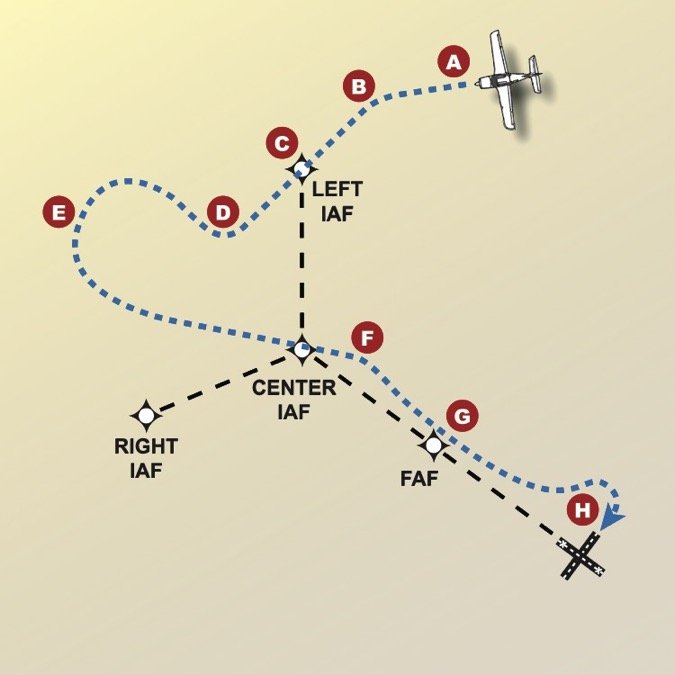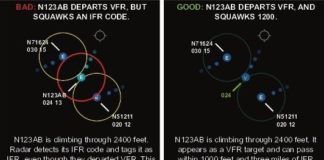I am not much for hero-worship, but there are definitely people on—and off—this planet whom I admire. One of them is astronaut Chris Hadfield, a fighter pilot, test pilot, veteran of two Space Shuttle flights, musician, and commander of the International Space Station for six months. He’s perhaps most famous for having recorded a music video where he performs David Bowie’s “Space Oddity” aboard the ISS.
From reading Hadfield’s autobiography An Astronaut’s Guide to Life on Earthand listening to various interviews online, it’s clear Hadfield is no stranger to unexpected problems. From a seagull strike in an F/A-18 Hornet fighter at 500 knots a mere 50 feet above the water, to temporarily going blind during his first spacewalk because of contamination in his helmet, he has faced some unique situations.

Resolving unusual situations isn’t just about acting quickly. It’s about acting correctly. What he did as an astronaut, what you do as a pilot, and what I do as an air traffic controller boils down to risk management and mitigation. There’s an entire chapter of Hadfield’s book titled, “What’s the Next Thing That Could Kill Me?” Its central tenet holds true: using good judgment with a minor problem can prevent it from becoming a major one.
That was on my mind last week, when I encountered a Columbia 350 pilot who seemed all out of sorts. The last thing I wanted to do was complicate an already bizarre situation. Arriving at a resolution took a balance of patience, teamwork, and knowing the limits of my regulations.
Wibbly Wobbly

To best understand what happened, kindly follow along with the graphic. Another controller fed the Columbia to my radar sector, direct to the left T-fix for the advertised RNAV approach. (A) After the pilot checked in, I soon noticed he was about 20 degrees off course for the fix. I asked him to verify he was direct. “Uh, I’m turning there now,” he replied. Fair enough. (B) I cleared him for the RNAV approach via that T-fix, expecting him to join the approach and track it inbound. I went back to my other traffic.
(C) The Columbia sailed on past the left T-fix. His current position made the center IAF the only option. I reached out. “Uh, [callsign], you were supposed to be direct [left T-fix]. Turn left direct [center IAF].” I re-cleared him for the RNAV approach via the new fix. He read back everything perfectly, if a little uncertain.
I dealt with some other traffic. (D) When my attention returned to the Columbia, to my shock, he’d turned away from the center IAF. I mean, literally opposite direction to where he was supposed to be going. Ooookay. “Columbia [callsign], I’m seeing you northwest-bound now. You were supposed to be headed southeast towards [center IAF]. Turn left heading one one zero and, when able, proceed direct [center IAF] and advise.”
(E) He read it all back perfectly, swung it around, and said he was on course to the IAF. I showed him tracking towards it. Perhaps the fabled third time would be the charm? Yet again, I cleared him for the approach.
I was definitely on my guard now. His destination airport had a runway closed. The advertised approach that he was supposed to be flying was an approach to the closed runway, with a circle to the active runway. That’s how I’d been clearing him. The way things were going, I was taking no chances. I verified on-frequency that he was aware of the runway closure and that he was supposed to circle to the other runway. It seemed to get across, although I can’t say for certain if he knew about it before I spoke up.
(F) Well, not surprisingly, he blew right past the center IAF. I’d held his hand as much as I could for an RNAV approach, but it wasn’t working out. At this point, I knew we had a problem. What to do now?
Alternative Actions
It was the time for Plan B, and to utilize all of my available information and resources. Clearly, the pilot was having RNAV equipment issues and the airport in question had only RNAV approaches available. So, what kind of approach requires no equipment aside from eyeballs? A visual approach, of course. That was my Plan B.
But wait! The ceilings were reported marginal, about 1700 scattered-to-broken throughout our airspace. Our Minimum Vectoring Altitude was 1700 as well. Controllers aren’t supposed to vector for a visual unless our ceilings are 500 feet above the MVA. If I said, “Vectors for visual approach,” I would be in violation of the ATC rules.
So, yeah, technically I couldn’t vector for a visual approach with the cloud bases as they were. However, what if I vectored him for an RNAV approach via the, err, scenic route … and my vector just happened to point him directly towards a base leg for the open, active runway … and the field was reporting VFR conditions … and the pilot just happened to pick up the field visually? Well, then I could clear him for the visual. (G) So, I told the pilot, “Descend and maintain 1700 and fly heading 140, radar vectors RNAV final approach course. Advise if you get the airport in sight.” I strongly emphasized the last part.
I wanted to give this pilot the best shot possible. I called the tower and requested they turn the runway lights on highest step. At first, the tower controller was perplexed. Despite the low clouds, the visibility was ten miles and it was broad daylight. Once I told him we had an aircraft having difficulties, he immediately complied.
Other pilots got roped into a situational resolution. I asked another aircraft for a PIREP to confirm the ceilings; the 1700 foot METAR was accurate. I also had a jet inbound to the same airport, which I slowed down and to which I issued some delay vectors. Per ATC rules, aircraft in distress have priority over all other aircraft. This Columbia wasn’t exactly an emergency yet, but he was a concern.
Thinking “worst case scenario,” I called a nearby control tower and told them to stop all departures. I didn’t want the wayward Columbia wandering in the face of any unforeseen departing aircraft, or attempting to land at the wrong airport. I also advised my supervisor, so he could monitor the situation. A second pair of eyes is never a bad thing.
Getting on Down
The Columbia trucked towards the airport. I called the field: “Twelve o’clock, six miles.” The pilot said he was looking. He was skirting the cloud bases, but I couldn’t descend him lower than the 1700 foot MVA. I was starting to doubt Plan B’s veracity.
Then, on top of that, I saw his target start to descend out of 1700 to 1600. While pilots aren’t allowed to deviate from ATC-assigned altitudes barring an emergency or collision-prevention—91.123—per our ATC rules an aircraft’s Mode C altitude is allowed to deviate a couple hundred feet before we declare it invalid. He was still in that “wiggle room” domain. Lest he inflict upon himself a pilot deviation, I quickly told him, “Do not descend. Maintain 1700.”
He immediately replied with some beautiful words: “I’ve got the airport in sight now.” (H) I immediately cleared him for the visual approach, told him to contact the tower, and breathed a sigh of relief. As he neared the airport, I brought in the waiting jet and told the neighboring tower to resume normal departures. I watched the Columbia’s target descend towards the airport and drop off my radar coverage. Shortly thereafter, the tower voice landline chimed and I picked it up. The aircraft was safe on deck.
I asked the tower to have the Columbia pilot give us a phone call once he parked. My supervisor answered the call. According to him, the pilot said—and I quote—”I had my head up my a**.” Apparently his avionics had rebooted in flight, causing some serious navigation issues. It also sounded like he was new to his airplane and its systems. I exchanged dozens of transmissions with him over quite a while, and not once did he mention any of this.
Maybe he was embarrassed, or unaware of just how in the weeds he actually was. The fact is, stuff happens. Mistakes are part of the human condition. Technology breaks too. Had I known he was having equipment issues from the get-go, I would have immediately aimed for a visual approach (within my regs) and saved us all a ton of frustration and distraction. If the weather wasn’t conducive for that Plan B, we could have given him time to troubleshoot his equipment and work out a Plan C, D, and so on. Perhaps he could have diverted to a different airport with better weather or a different, ground-based approach (ILS, VOR, etc.) We would’ve worked it out somehow.
Fessing Up
If you’ve been reading my articles in IFR over these past years, you’ll note a recurring theme: if you have a question or issue, speak up. ATC is there to provide a service to you and the flying public, its customers. We cannot provide good service if we don’t have good information on which to act.
If there’s something wrong, even if it’s your fault, don’t keep secrets. Need an extreme example? Let’s time travel for a moment. In 1980, during the height of the Cold War, two U.S. Air Force technicians went into a missile silo in Arkansas to conduct a pressure check on a nuclear-tipped Titan II intercontinental ballistic missile. They incorrectly used a ratchet and socket for the task. The eight-pound metal socket slipped out of their grasp, plunged 80 feet and punctured the missile’s fuel tank. Alarms went off in the control room. The missile crew went through checklist after checklist, futilely trying to figure out why their missile was suddenly losing pressure.
Half an hour passed before the techs confessed to the silo commander what had happened. By that point, the complex was already filled with volatile fuel vapors, forcing them to evacuate via an escape hatch. Despite multiple attempts at resolution, nine hours later, the missile exploded, killing one man, obliterating the entire silo, and sending the nine megaton nuclear warhead careening through the air. Had the warhead’s safety mechanisms not functioned when it hit the dirt, a significant portion of Arkansas would have ceased to exist. Had the techs fessed up sooner, perhaps there would have been a different outcome, a life would not have been lost, and an entire state would not have been put at risk.
It’s Inevitable, Now or Later
The reality is this: eventually, the truth comes to light. We’re not talking about taking your parents’ car for a joy ride as a teenager and then denting the fender. Aviation is a volatile and risk-inherent activity where stuff happens. It’s almost always far better if the truth comes out early and completely, on frequency, so a controller can deal with it appropriately right then, rather than handle it later via an NTSB post-accident investigation.
Is there fear of punishment? Perhaps, but keep it all in perspective. I know that if I’d banged up my parents’ car as a kid, they wouldn’t be thrilled. However, regardless of the specifics and who was at fault, the most important thing to them would be that I was okay. I may face some serious music if I acted recklessly or tried to cover it up, but at least I was alive to face it.
On that note, don’t assume that every incident is going to put you under a microscope. In this Columbia’s situation, it was a non-issue. No reports. No investigators. No emergency was declared. There were just two “calls”: the physical phone call to get some clarity for us, and, hopefully, a wake-up call to the pilot.
I also believe in self-assessment. After a situation concludes, I always ask myself what I could have done better. In this case, I could have flat-out asked the pilot if he required any assistance or if he was having difficulties. In the thick of it, it seemed pretty obvious he was having navigation issues of some sort. However, I could have gotten definitive confirmation. It’s a lesson I banked for the next time I face such a situation.
As Chris Hadfield said in his book, “What’s the next thing that can kill me?” Don’t let keeping secrets from ATC become that “thing.” Share the info so we can help you accomplish the most important task— getting you safely on the ground.
Tarrance Kramer can read between a lot of lines, but he’s no mind reader. He much prefers everyone on his frequency be up front while he works traffic in the Midwest.





